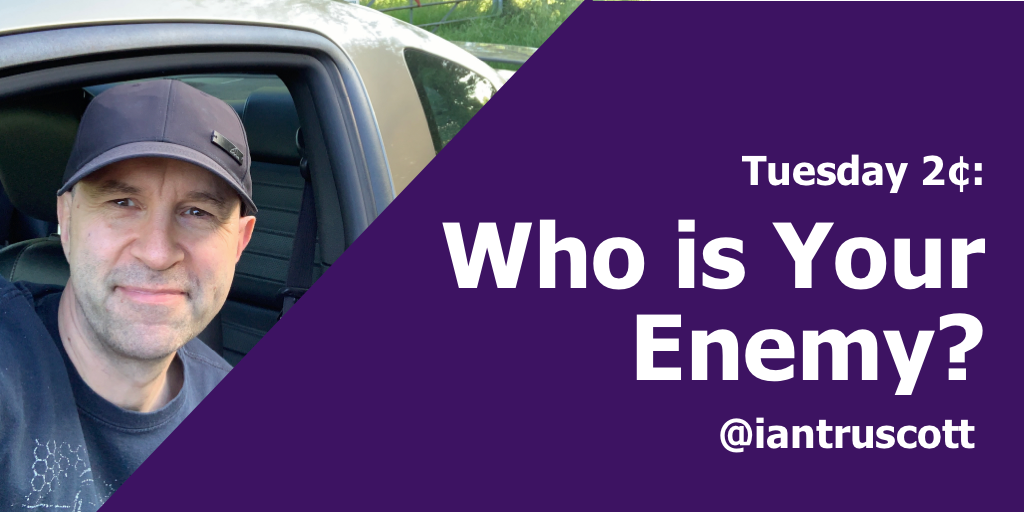Tuesday 2¢: Who is Your Enemy?
Buyers don't always think of who can solve their problems like you do. A quick story, quoting Seinfeld and Levitt, suggests that maybe the thing that stands in the way of your business, your enemy, is not always a competitor.

Buyers don't always think of who can solve their problems like you do. A quick story, quoting Seinfeld and Levitt, suggests that maybe the thing that stands in the way of your business, your enemy, is not always a competitor.
Last year, I did not own a car. OK, a slight lie, I did, I owned (and still do) a 2005 Ford Mustang, which I consider more of a drive ornament. When it came to serious car business, like taking a daughter to university, visiting family in Norfolk (a faraway place), holidays, a serious business meeting or, well, pretty much anything that would be solved by a car, I would hire a car.
The system served me well for years. One of the big brand hire companies opened a branch in my town, an easy walking distance away. I am interested in cars, I liked the serendipity of not knowing what model I would drive, trying new models, and I got on a first-name basis with the manager and some of the staff, they knew what I wanted, and this worked well for years.
And then COVID hit, they shrank the fleet, service drifted as the big hire car brand cut costs, and it was harder to get the exact vehicle specification I needed, for, say, when you need to move the ridiculous amount a university student can fit into a room at a hall of residence. It’s a tardis I tell you!
So, yes, that’s a premium coupe, it's lovely, I understand how hard it was to find a premium car, yes, I know, you know, I like premium cars, I love it, but I had a reservation for an SUV….. (Yep, that Seinfeld episode, they took the reservation, but they could not hold the reservation).
They became unreliable, which was bad, not because it inconvenienced me, but because I had made a promise to my daughter, my family or some other commitment. So each car hire booking was no longer joyous serendipity but a moment of anxiety that I might not be able to keep that promise.
So, what did I do?
Did I go to a competitor?
No, I bought a car.
OK, technically, another car, but a car that could do all the car things.
The inconvenience of the service and the anxiety of whether I could keep my promises outweighed my joy in driving a range of new cars. I like to hire nice cars, so the price/budget was not wildly different. The difference was convenience.
Jed, the hire car branch manager, would offer me incentives when it went wrong, but he was not competing for my hire car business he was competing for my car business.
And that’s the point of this post, in whatever you market or sell – who is your enemy?
And like my Seinfeld quote, I am obliged to dip into another classic, Theodore Levitt, Marketing Myopia – Ask, what business are you in?
His often-quoted observation on the decline of the US railway system as it got crushed by the automobile and highways, that they “assumed themselves to be in the railroad business, rather than the transportation business” was just like my chum Jed, who maybe didn’t run a railroad, but a branch of a hire car company, assuming he was in the hire car business.
In my field – B2B software, we often get fixated with our competitors that look at the problem the same way we do. Like Jed might have worried about Hertz for my business, rather than Cazoo (a UK company, where you can buy a car and they bring it to your house).
We worry about the others in the Gartner Magic Quadrant, or the Forrester Wave or whichever vendor the CEO saw in his social feed, advertised in between his YouTube videos or in the inflight magazine.
But we need to think about what the buyer is trying to achieve. What job do they need to get done? What promise are they making to whoever depends on them, their customer, stakeholders etc? And how else could they do it?
The enemy could be doing nothing. What they do now is fine, that trusty excel spreadsheet, legacy product or ball of twine and duct tape. The sales and marketing challenge is to get them to act, whichever competitor they choose.
Or the enemy could be the attention and budget some other shiny project is getting. The sales and marketing challenge is to get them to prioritise the problem you solve, whichever competitor they choose.
Or the enemy could be a barely-there new feature of a trusted big box platform they already own (a SAP, Oracle or Adobe) that can kinda, sorta, do close to what they need. The sales and marketing challenge is convincing them they need a specialist tool for the job, whichever competitor they choose.
Or the enemy could be a new way, a new category, a disruptor, the automobile to our railroad. The sales and marketing challenge is stay relevant as the category expands, whichever competitor they choose.
The enemy may not be your competitor, the enemy could be the buyer not looking at your category to solve their problem.